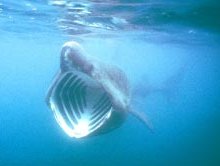
This large fish is a very harmless shark, which feeds by straining plankton from surface waters.
This species of shark occurs in many cool temperate oceans, from oceanic water to close inshore. It is occasionally seen around New Zealand, with most sightings in the Cook Strait and down to Kaikoura, and Dunedin down to the to Foveaux Strait regions. It often swims at the surface.
Basking sharks are also found off the coasts of South Africa, North America, southern Alaska, southern Canada, the entire coastline of Europe, as well as off the southern coast of Australia, most of southern South America, the Red Sea, and the coastlines of China and Japan.
The basking shark is a huge filter feeding shark which grows to be up to about 10 mts or 33 feet long. It is the second largest shark in the world ( the whale shark being the largest).
Basking sharks normally swim around alone, though sometimes they are seen in pairs, or in groups of up to 100.
Basking sharks are slow swimmers, they swim no more than 3kph or 3 mph. They swim by moving their entire bodies from side to side (not just their tails, like some other sharks do).
They migrate seasonally, eating in cool northern waters, moving south during the winter.
The snout is short and conical. It has a huge mouth which it uses to collect tiny food that floats in the water. They have numerous minute teeth (but they are tiny and are of little use), huge gills and dark, bristle like gill rakers, and it filters its food (plankton) from the surface waters.
The female Basking sharks grow up to 10mts or 33ftlong, the males grow slightly smaller 9mts or 30ft long. This enormous shark also weighs up to 4 tons.
Being filter feeders the basking shark swims with its mouth open, masses of water filled with plancton and any small fish that get in the way flow through its mouth.
After closing its mouth, the shark uses gill rakers that filter the nourishment from the water.
Gill rakers are bristly structures (the thousands of bristles are about 10cm or 4") in the shark's mouth that trap the small organisms which the shark then swallows. The water is expelled through the shark's 5 pairs of gill slits. The shark can process over 6000lts or 1500 gallons of water each hour.
These large sharks reach sexual maturity at about 2 to 4 years of age.
The gestation period is long about 3.5 years. Females give birth to 1 to 2 live young. which are about 1.7mts or 5.5 ft long. These are the largest shark pups.
Like all sharks, fertilization of the eggs occurs within the female. The eggs hatch within the female and are nourished by eating unfertilized eggs in the womb. There is no placenta to nourish the babies - they must fend for themselves, even before birth.
They swim away from the mother immediately after birth, there is no maternal care-giving.
The number of basking sharks is not known, but it may be decreasing since the basking shark is hunted for its meat, fins and oil.